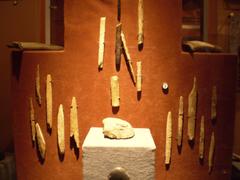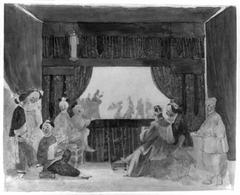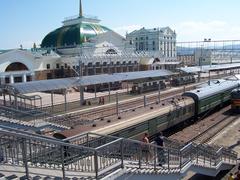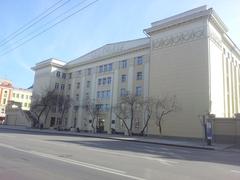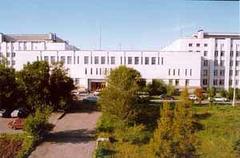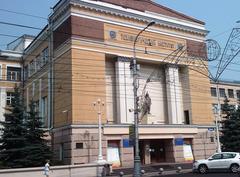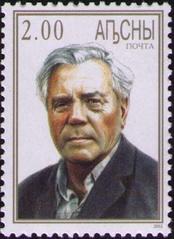
Krasnoyarsk Ostrog Visiting Hours, Tickets, and Historical Sites Guide
Date: 03/07/2025
Introduction: Krasnoyarsk Ostrog—A Window into Siberian History
At the meeting point of the Kacha and Yenisei rivers stands Krasnoyarsk Ostrog, the historic heart of modern Krasnoyarsk. Founded in 1628 by Cossacks under Andrei Dubensky, this wooden fortress was pivotal in Russia’s 17th-century advance into Siberia. Serving as both a military outpost and a center for administration and trade, Krasnoyarsk Ostrog symbolizes the resilience, multiculturalism, and frontier spirit that shaped Siberia (historyancient.ru; admkrsk.ru). Today, the site offers visitors a blend of archaeological intrigue, reconstructed fortifications, and panoramic city views, making it a must-see for history lovers and cultural explorers alike.
This guide provides comprehensive information on visiting hours, tickets, accessibility, travel tips, and essential highlights, ensuring a rewarding visit to Krasnoyarsk Ostrog and its surrounding historical sites.
Table of Contents
- Origins and Strategic Foundations
- Architecture and Military Role
- The Ostrog’s Transformation and Urban Expansion
- Planning Your Visit
- Cultural and Social Legacy
- Practical Visitor Tips
- Frequently Asked Questions (FAQ)
- Summary and Recommendations
- References and Further Reading
Origins and Strategic Foundations
Krasnoyarsk Ostrog was established in 1628 by 300 Cossacks led by Andrei Dubensky. The site—chosen for its defensibility and access to river routes—stood on the left bank of the Kacha River, near today’s city center and opposite Tatyshev Island (historyancient.ru). The indigenous Kachin called the area “Khyzyl Char” (“Red Bluff”), inspiring the name “Krasny Yar” or “Beautiful Coast” (de.vogueindustry.com).
From its earliest days, the ostrog served as a linchpin for Russian expansion, controlling the crucial Yenisei waterway and defending against threats from neighboring tribes.
Architecture and Military Role
The original ostrog featured high timber palisade walls, watchtowers, and a central blockhouse, forming a formidable defense against attacks (cyberleninka.ru). The “Double enforced ostrog” design, with curtain walls nearly 240 meters long along the riverside, exemplified advanced frontier architecture adapted to Siberia’s environment.
As a military and administrative hub, the fort was vital in securing Russian authority, collecting tribute, and protecting settlers. Despite multiple sieges—most notably by Kirghiz forces in the 1600s—the fort survived and grew, attaining city status by 1690 (de.vogueindustry.com).
The Ostrog’s Transformation and Urban Expansion
By the 18th century, Krasnoyarsk Ostrog had evolved into a flourishing town. The Siberian Highway’s construction spurred trade and migration, expanding the population and infrastructure (admkrsk.ru). After a major fire in 1784, the city was rebuilt with a new layout influenced by St. Petersburg, further shaping its urban identity.
Cultural influences multiplied as Russian settlers, Cossacks, indigenous peoples, and exiles mingled, laying the groundwork for Krasnoyarsk’s reputation as the “cultural capital of Siberia.” The arrival of the Great Siberian Railway in 1895 cemented its role as a transport and trade nexus.
Planning Your Visit
Visiting Hours and Ticket Information
- Ostrog Site: The open-air grounds are accessible year-round, typically from 8:00 AM to 8:00 PM in summer; hours may be shorter in winter.
- Krasnoyarsk Regional Museum: Open Tuesday–Sunday, 10:00 AM–6:00 PM (last admission 5:30 PM).
- Tickets: Entry to the outdoor site is free. Museum admission is generally 200–300 RUB for adults, with discounts for students and seniors. Guided tours may incur additional fees (museum.krsk.ru).
Guided Tours and Accessibility
- Guided Tours: Available in Russian, with occasional English-language options. Self-guided audio tours (downloadable via apps) provide flexible exploration (Eventbrite).
- Accessibility: Most museum areas and city streets are accessible for visitors with limited mobility, though some outdoor paths and reconstructed elements may be uneven.
Getting There
Krasnoyarsk Ostrog is centrally located in the Tsentral’nyy District, a short walk from major landmarks and well-served by buses and trams. The main railway station is nearby, offering easy access for travelers on the Trans-Siberian Railway (Express to Russia).
Nearby Attractions and Photo Spots
- Paraskeva Pyatnitsa Chapel: Offers panoramic city and river views; originally a watchtower site (wildtrips.net).
- Tatyshev Island and Yenisei Embankment: Ideal for walking and nature lovers.
- Reconstructed Fortifications: Reimagined palisade walls and towers provide engaging photo opportunities.
- Museum Exhibits: Artifacts, dioramas, and multimedia displays at the Regional Museum illustrate daily life in the ostrog era (fabrikantgruppen.com).
Cultural and Social Legacy
Krasnoyarsk’s status as an administrative and cultural center is rooted in its ostrog heritage. The city became a hub for exiles and political prisoners in the 19th century, including the Decembrists, whose influence fostered a vibrant intellectual and artistic scene (admkrsk.ru). Today, museums, festivals, and educational programs celebrate this multicultural legacy, bringing Siberia’s diverse history to life.
Practical Visitor Tips
- Best Time to Visit: June–August offers warm temperatures (20–25°C) and extended daylight. Spring and early autumn are also pleasant; winter is cold but atmospheric (TravelSetu; hikersbay.com).
- Dress: Wear comfortable shoes and bring layers (weather can change rapidly).
- Food and Amenities: Numerous cafes, restrooms, and souvenir shops are nearby (TravelSetu).
- Safety: Krasnoyarsk is generally safe; standard precautions are advised.
- Language: Most information is in Russian; translation apps or a local guide can be helpful.
- Connectivity: Free Wi-Fi is available in many cafes and public spaces.
- Accessibility: Museums have ramps and elevators; some outdoor areas may require assistance for those with mobility challenges.
- Emergency Services: Police (102), Ambulance (103); travel insurance is recommended (HikersBay).
Frequently Asked Questions (FAQ)
Q: What are the visiting hours for Krasnoyarsk Ostrog and museums?
A: The outdoor site is generally open from 8:00 AM–8:00 PM in summer; museums operate 10:00 AM–6:00 PM.
Q: Is there an admission fee?
A: Outdoor areas are free; museum tickets range from 200–300 RUB.
Q: Are guided tours available in English?
A: Some English audio tours are available; in-person tours are mostly in Russian.
Q: Is the site wheelchair accessible?
A: Most areas are accessible, but some outdoor surfaces may be uneven.
Q: What else should I see nearby?
A: Paraskeva Pyatnitsa Chapel, Tatyshev Island, and the Yenisei River embankment.
Summary and Recommendations
Krasnoyarsk Ostrog offers a profound journey into Siberia’s early days—whether you’re tracing the city’s Cossack roots, exploring reconstructed fortifications, or enjoying panoramic views over the Yenisei. Flexible access, affordable ticketing, and a wealth of nearby attractions ensure a rewarding experience for all visitors. Enhance your exploration with an audio tour or guided walk, and don’t miss local festivals and museum programs that bring this storied site to life (vamados.com; de.vogueindustry.com). For practical guidance and official updates, consult the Krasnoyarsk Regional Museum website and Krasnoyarsk Tourism Board.
References and Further Reading
- historyancient.ru
- de.vogueindustry.com
- cyberleninka.ru
- admkrsk.ru
- vamados.com
- fabrikantgruppen.com
- wildtrips.net
- Eventbrite
- TravelSetu
- HikersBay
- museum.krsk.ru
- krasnoyarsk.travel
- explorecity.life
- Express to Russia


